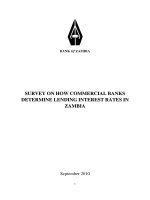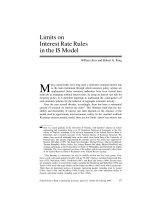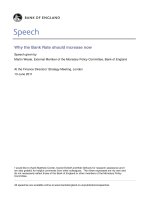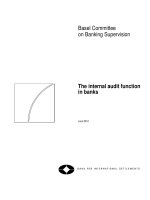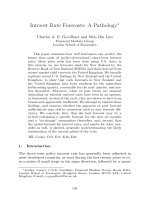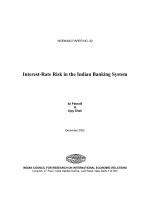Variable Mortgage Rate Pricing in Ireland docx
Bạn đang xem bản rút gọn của tài liệu. Xem và tải ngay bản đầy đủ của tài liệu tại đây (1 MB, 12 trang )
Economic Leer Se
Variable Mortgage Rate Pricing in Ireland
Jean Goggin, Sarah Holton, Jane Kelly, Reamonn Lydon and Kieran McQuinn
1
Vol 2012, No. 2
Abstract
This Letter examines movements in the interest rates charged on variable rate mortgages. The results indicate that
variable rates for all lenders closely followed changes in the ECB’s policy rate, short-term wholesale rates and tracker
rate mortgages until the end of 2008. Thereafter, the relationship breaks down, in part due to banks’ increased
market funding costs. It appears that some lenders with higher mortgage arrears rates and a greater proportion of
tracker rate loans on their books exhibit higher variable rates. After controlling for these additional factors, most of
the divergence between banks variable rates is explained, but there are some exceptions. There is also some evidence
of asymmetric adjustment in rate setting behaviour: that is, rates tend to adjust slowly when they are above the
long-run predicted level but more quickly when they are below this level. This asymmetric adjustment behaviour
appears to increase in the post-2008 period.
1 Introduction
Irish mortgages can be on a fixed or variable rate,
with the vast majority (85 per cent) on the lat-
ter. There are two types of variable rate loans:
those that track the ECB base rate at an agreed
margin, typically called ’trackers’, and those that
do not. In the latter case, the lender offers no
specific link to an underlying market or wholesale
rate and can choose to increase or decrease the
rate at its discretion. In this paper when we re-
fer to variable rate mortgages, we exclude track-
ers. The most common variable rate product is the
Standard Variable Rate or ‘SVR’. For most of the
last decade, lenders’ SVRs closely followed their
tracker rates, with an average difference between
the two of 0.20 percentage points from 2003 to
2008. However, since the end of 2008, the two
interest rates have diverged with the average dif-
ference reaching 2 percentage points by November
2011 (see Figure 1).
The increase in variable rates since mid-2009
varies across institutions. Understanding why this
is happening and how banks set variable rates
is important, not least in the context of current
concerns about affordability and borrower distress.
This Letter aims to answer two questions:
1
Contact author: +353-1-224-6809. The views expressed in this paper are those of the
authors only, and do not necessarily reflect the views of the Central Bank of Ireland or the ESCB. We would like to thank
Martina Sherman for research assistance. We would also like to thank Stefan Gerlach, Trevor Fitzpatrick, Maurice McGuire,
Robert Kelly and Eamonn Leamy for their comments on earlier drafts. This version as of 31 January 2012 incorporates revisions
to estimated ELG and total funding costs including ELG in Table 2 and related references.
Goggin et al., Variable Mortgage Rates
• What explains the changes in variable rates
over time, and in particular what explains di-
vergence from tracker rates in recent years?
• Why have some lenders increased variable
rates more than others?
Our approach draws on both the monetary pol-
icy (Rousseas, 1985) and the industrial organi-
sation literature (Klemperer, 1987 and Cecchin,
2011) on interest rate pass-through by looking at
banks’ pricing of loans and deposits from a cost of
funds perspective.
2 Variable rates and the Irish
mortgage market in context
Variable rate mortgages account for one third of
balances and one-half of loans in each of the
owner-occupier and buy-to-let segments. In the
owner-occupier segment, the average balance on
a variable rate mortgage as at end 2010 was
€90,000, equal to approximately half the average
balance of a tracker mortgage. Variable rate mort-
gages tend to be older vintage loans: 70 per cent
of mortgages originating prior to 2001 are vari-
able rate loans. From early-2009 onwards lenders
stopped offering Tracker mortgages when the un-
derlying margin risk was starkly exposed by the fi-
nancial crisis (i.e. margins were too low and inflexi-
ble given the new market funding environment). In
the last two years, the majority of new mortgages
have been on a variable rates.
There are considerable differences between
lenders in the share of balances accounted for by
variable rate loans, ranging from 19 to 56 per cent.
Lenders with a lower share of variable rate loans
tend to have a higher share of tracker mortgages,
as fixed rate mortgages account for less than 20
per cent of balances across most banks. When one
part of a lender’s book is unprofitable, banks may
increase rates on other loans to compensate. We
test this hypothesis in the econometric modelling
below.
The difference between variable and tracker
rates rose from close to zero at the end of 2008, to
over 2 percentage points by November 2011. The
bottom panel in Table 1 shows the average interest
rate by rate type and market segment (owner occu-
pier versus buy-to-let) on existing loans in Novem-
ber 2011. The range between variable and tracker
rates varies between 1.4 to 2.8 per cent, indicat-
ing that some lenders have increased variable rates
more than others.
3 Bank funding costs and in-
terest margins
Lenders’ funding costs and net interest margins
have undergone significant change in recent years.
These changes may feed into higher variable rates
as lenders seek to re-build net interest margins and
cover higher costs arising from increased borrower
credit risk and changes to regulatory capital re-
quirements (see, for example, the higher ratios re-
quired under Basel III).
Irish banks’ net interest margins have declined
over the last two decades, averaging 1.6 per cent in
the 2005 to 2008 period (Figure 3). The pressure
on net interest margins is likely to remain intense
given the high level of provisions required to cover
distressed loans, limited new lending and, in some
cases, large unprofitable tracker loan books.
Prior to the onset of the banking crisis, Irish
banks accessed short term wholesale funding at
rates close to euro area benchmarks. An ECB
survey confirmed that variable rate pricing was
largely based off the ECB main refinancing rate
or 3-month Euro Interbank Offered Rate (Euribor)
for Irish lenders in 2007 (ECB Occasional Paper,
2009). This explains why variable rates followed
tracker rates so closely up to the end of 2008.
In the last three years Irish banks have expe-
rienced significant funding outflows, in particular
for corporate deposits and wholesale debt securi-
ties (Figure 4). In November 2011 Central Bank
funding constituted around 21 per cent of funding
for the domestic market credit institutions.
2
Banks also pay a fee to the government for the
Eligible Liabilities Guarantee (ELG
3
) which covers
deposits, certificates of deposit, commercial paper,
2
This figure and the series shown in Figure 4 are based on statistical balance sheet data, which provide details of the
liabilities of within-the-state offices or brances of credit institutions. The data are unconsolidated, however, for the purpose of
this analysis they have been adjusted to exclude deposits from resident and foreign affiliated MFIs.
3
The ELG, introduced in December 2009, provides a Government Guarantee on certain liabilities of a number of credit in-
stitutions in Ireland and is one of a range of measures designed to stabilise confidence in the domestic banking system. Further
details on the ELG are available from the Department of Finance: http://www.finance.gov.ie/viewdoc.asp?DocID=7071.
2
Goggin et al., Variable Mortgage Rates
senior unsecured bonds and notes and other senior
debt. The covered banks have paid fees to date
of €1.8 billion for the scheme. The quantity of
assets guaranteed by the state has fallen from a
peak of €375 billion in Q3 2008 (under the previ-
ous broader scope scheme) to €100 billion in Q3
2011, reflecting the funding outflows and short-
ened maturity profile experienced by the covered
institutions. Nonetheless, given the increasing fee
structure imposed by the European Commission
over time to incentivise exit, the Department of
Finance estimate that the average effective ELG
cost has doubled since introduction from 50bps to
100bps in Q3 of 2011.
Table 2 shows an estimate of the price and
quantity components of funding costs, as at De-
cember 2011 for the FMP institutions. The calcu-
lation uses group level volume data on funds out-
standing by instrument, and makes a number of
simplifying assumptions as to the interest rates for
each funding component. On the basis of these fig-
ures, we estimate average funding costs for these
institutions of around 2.6 per cent. This compares
with an average standard variable mortgage rate
of 3.9 per cent in December 2011. The estimates
in Table 2 should be treated as a guideline since it
is subject to a number of assumptions (see table
notes) and also excludes costs relating to credit
risk, operating costs, the costs of holding capital
and liquidity costs.
Nonetheless, the estimate does inform our un-
derstanding in a number of ways. First, it suggests
that banks cost of funds are significantly higher
than the ECB base rate (1.00 per cent) or 3-month
Euribor (1.36 per cent) alone would suggest. Intu-
itively, therefore, one might expect variable rates
to be higher than tracker rates, which incorporate
a typical margin of 1 to 1.3 per cent. Second, the
range of cost estimates (0.65 per cent between low-
est and highest) is narrower than the range of vari-
able mortgage rates set by these institutions (1.95
per cent between lowest and highest). Hence there
may be merit in checking whether other factors, in
addition to funding costs, help explain the diver-
gence across institutions. In the modelling sec-
tion below we incorporate what panel data there
is on funding costs (Euribor, ’Eonia’ (the Effective
Overnight Interest Rate on unsecured lending in
the interbank market) and ELG fees) to test this
relationship more formally.
We can also use the funding cost estimates to
get a sense of how overall costs might respond
to a hypothetical change in a particular element
of funding. For example, suppose we reduce the
cost of central bank funding by 0.25 per cent,
while holding all other funding costs constant, the
weighted average cost of banks funding falls by
0.06 per cent. In practice, the impact might vary
depending on the rates banks offer on other ele-
ments of funding such as retail and corporate de-
posits. In other words, whether they also cut de-
posit rates in response to an ECB rate cut. The
quantities of funding from each source are also
likely to evolve over time. In particular, reliance on
central bank funding is not a sustainable strategy
for the future even if it is cheaper at present. Fur-
thermore, the domestic banks are obliged to reduce
their loan to deposit (LDR) ratios to 122.5 per cent
by end 2013 as part of the Financial Measures Pro-
gramme to help create a clean, appropriately-sized
banking system and make market funding more at-
tainable.
4 Modelling the determinants
of variable mortgage rates
In this section we test the hypothesis that up to
the end of 2008 Irish lenders used the ECB base
rate or 3-month Euribor as the primary benchmark
for adjusting the pricing of variable rate mortgages.
After 2008, however, three major changes occured
which affected the lenders’ pricing of variable rate
mortgages. The first of these is the increase in
funding costs arising from the banking crisis. The
second is the increased pressure on margins aris-
ing from greater credit risk and ongoing losses on
lenders’ tracker loan books. The third change is
the decline in the number of active lenders in the
market from twelve to five in recent years and the
resulting change in competition.
Our econometric model extends the basic pass-
through model in the literature to include bank
specific and market features.
4.1 Structural break tests
We first test for a break in the relationship between
the variable rate and Euribor in or around the end
of 2008.
There is no particular reason to expect a one-
to-one pass through from the Euribor rate to vari-
able interest rates, as a variety of factors such as
operating costs, credit risk, menu costs and other
3
Goggin et al., Variable Mortgage Rates
longer-term funding costs not directly captured in
a univariate setting could also determine rates (see,
for example, Klemperer, 1987).
Figure 5 summarises the results from a re-
cursive analysis of the pass-through rate for nine
lenders. Up to the end of 2008 the pass through
rate was between 0.50 and 0.70 across all banks,
after which point it fell to around 0.30. Based on
this result, the remainder of the analysis in this
section estimates separate models for the periods
pre- and post- the end of 2008.
4.2 Analysis of variable rates for five
lenders
We analyse the rate-setting behaviour of five
lenders between 2003 and 2011: Allied Irish Banks,
Bank of Ireland, Educational Building Society, Per-
manent tsb and ICS Building Society. We use an
approach called panel data analysis to analyse the
key drivers of changes in variable rates both over
time and across lenders. Further information on
model choice, variables used (and not used) and
the full range of econometric techniques employed
is provided in the accompanying Technical Paper
to this Letter (Goggin et al. 2012).
For the period up to the end of 2008, the re-
sults of our analysis can be summarised as follows:
• The two funding cost measures that best ex-
plain variable rates are bank deposit rates
and Euribor, both of which are strong pre-
dictors of changes in interest rates up to the
end of 2008.
• We find that when competitive pressures (as
measured by a market concentration index
based on shares) are higher, variable interest
rates tend to be lower, all other factors held
constant.
• The mark-up of variable rates over funding
costs was 1.4 percentage points during this
period, and was the same across all lenders.
• When variable rates are below the level im-
plied by lenders’ funding costs the upward
adjustment is quicker than when rates are
above this level - in other words lenders ap-
pear to behave asymmetrically when adjust-
ing rates to the long-run level.
For the period from 2009 onwards, the key re-
sults are as follows:
• The breakdown in the pass-through rate
from Euribor is partly explained by increases
in crisis-related measures of banks’ funding
costs such as ELG fees (which we estimate
account for around a sixth of funding costs)
and Euribor-Eonia spreads.
• Changes in the rate of mortgage arrears also
drive changes in variable rates, controlling
for funding costs.
• It appears that some lenders are charging
higher variables rates to compensate for the
losses they are making on their tracker loans.
• The asymmetric adjustment behaviour is ac-
centuated in the later period, perhaps indica-
tive of lenders’ increasing pricing power in
this period.
• One bank’s (A) variable rates are signifi-
cantly lower and another bank’s (F) variable
rates are significantly higher than its peers,
controlling for funding costs, arrears rates
and other factors.
The inclusion of the arrears rate in the second
period is so as to capture the pressure on net in-
terest margins from increased credit risk. Figure 7
shows some cross plots of the variable rate-arrears
relationship.
The direction of causality from arrears to in-
terest rates (or vice-versa) is important. The ac-
companying technical paper presents a range of
evidence on the nature and direction of the re-
lationship. The results from a set of causality
tests provide strong evidence that higher arrears
do cause higher interest rates. We also find some
evidence of reverse causality, i.e. that higher inter-
est rates can increase arrears, although this result
differs across banks. Lydon and McCarthy (2011)
use micro data to analyse the determinants of loan
arrears and find that payment to income ratios,
which indirectly include interest rates, are a strong
predictor of arrears. Our results justify the inclu-
sion of arrears as an explanatory variable for inter-
est rates, while not excluding the possibility that
causality is bilateral.
4
Goggin et al., Variable Mortgage Rates
5 Conclusion
This note sets out to study trends in variable mort-
gage rates in recent years. We find that before the
end of 2008 variable rates are explained by three
factors: funding costs, competitive pressures and
a mark-up over funding costs. The two measures
of funding costs that best account for movements
in variable rates in this period are deposit rates
and the Euribor rate, with a pass-through rate for
the latter of approximately 0.6. The mark-up over
funding costs is not significantly different among
banks during this period.
The main reason variable rates diverge from
tracker rates after 2008 is that banks’ funding costs
and related pressure on variable rates are no longer
captured by Euribor, whereas tracker rates con-
tinue to follow policy rates and the Euribor rate.
For example, we find that crisis-related measures
of funding costs, such as the ELG fee and Eo-
nia spreads, are positively correlated with variable
rates and, in the case of the ELG fee, can account
for approximately a sixth of funding costs.
The analysis suggests costs relating to in-
creased credit risk may be becoming an increas-
ingly important factor in setting variable rates.
Banks with higher arrears rates exhibit higher vari-
able mortgage rates. The second result from our
analysis is that it appears that some lenders are
charging higher variables rates to compensate for
the losses they are making on their tracker loans,
controlling for our estimates of funding costs. A
risk with such a strategy is that it may be counter-
productive and continue to exert upward pressure
on arrears. We find that after controlling for these
additional factors, most of the divergence between
banks SVRs is explained.
References
[1] Bredin, D., T. Fitzpatrick and G. O’Reilly, 2001, Retail interest rate pass-through: the Irish experience,
Central Bank of Ireland Technical Paper 06/RT/01, November.
[2] Cecchin I., 2011, Mortgage rate pass-through in Switzerland, Swiss National Bank Working Paper
Series, 2011/08.
[3] De Graeve, F., O. De Jonghe and R. Vander Vennet, 2007, Competition, transmission and bank pricing
policies: Evidence from Belgian loan and deposit markets, Journal of Banking and Finance, 31, 259-278.
[4] Eurosystem Monetary Policy Commitee Task Force, March 2009, Housing Finance in the Euro Area,
ECB Occasional Paper Series No. 101.
[5] Gambacorta, L., 2004, How do banks set interest rates? NBER Working Paper Series No. 10295.
[6] Goggin, J., S. Holton, J. Kelly, R. Lydon and K. McQuinn, Variable Rates in the Irish Mortgage Market,
Central Bank of Ireland Research Technical Paper Series, Forthcoming.
[7] Ho., T.S.Y. and A. Saunders, 1981, The determinants of bank interest margins: Theory and empirical
evidence, Journal of Financail and Quantitative Analysis, 16(4) November.
[8] Hofmann, B. and P. Mizen, 2004, Interest rate pass-through and monetary transmission: Evidence from
individual financial institutions’ retail rates, Economica 71, 99-123.
[9] Kelly, R., Y. McCarthy and K. McQuinn, Impairment and Negative Equity in the Irish Mortgage Market,
Central Bank of Ireland Research Technical Paper, 09/RT/11
[10] Kennedy G. and T. McIndoe Calder, 2011, The Irish Mortgage Market: Stylised Facts, Negative Equity
and Arrears, Central Bank of Ireland Research Technical Paper, 12/RT/11
[11] Klemperer, P., 1987, Markets With Consumer Switching Costs, Quarterly Journal of Economics,
102(2), May 1987
5
Goggin et al., Variable Mortgage Rates
[12] McQuinn, K, Smyth, D. and G. O’Reill (2009), Supply response in an uncertain market: Assessing
future implications for activity levels in the Irish housing sector, European Journal of Housing Policy,
Vol 9(3), pp.259-283.
[13] Pautkuri, H., 2010, Housing loan rate margins in Finland, Bank of Finland Research Discussion Papers
10/2010.
[14] Raknerud, A., B.H. Vatne and K. Rakkestad, 2011, How do banks funding costs affect interest margins?
Norges Bank Working Paper, 2011/09.
[15] Rousseas, S., 1985, A markup theory of bank loan rates, Journal of Post Keynesian Economics, 8(1).
[16] Stiglitz J.E. and A. Weiss 1981, Credit Rationing in Markets with Imperfect Information, The American
Economic Review, 71(3), 393-410.
6
Goggin et al., Variable Mortgage Rates
Table 1: Interest Rates: Summary Statistics
Share of mortgage interest rate type (% balance)
Owner-Occupier Buy-to-Let
Mean Min Max Mean Min Max
Variable 33 19 56 30 13 45
Tracker 51 22 62 62 49 85
Fixed 16 10 22 8 2 18
Range of interest rates (per cent) November 2011
Owner-Occupier Buy-to-Let
Mean Min Max Mean Min Max
Variable 4.5 3.5 5.4 4.7 3.5 6.4
Tracker 2.3 2.1 2.6 2.3 2.2 2.3
Fixed 4.3 3.8 5.3 4.7 4.2 5.2
Source: Central Bank of Ireland, loan level data
7
Goggin et al., Variable Mortgage Rates
Table 2: High Level estimate of bank funding costs
€Billion Average IR (per cent)
Total Retail Deposits 123.2 1.86
Total Corporate & NBFI Deposits 22.2 1.63
Certificates of Deposit 0.3 3.55
Total Long Term Debt Capital Markets
Secured Borrowings 18.3 3.93
Unsecured Unguaranteed Borrowings 8.6 4.55
Unsecured Guaranteed Borrowings 17.0 4.18
Subordinated Debt 3.8 10.63
Repos and Other Secured Funding 14.9 3.54
Interbank 4.3 3.56
Central Bank 70.0 1.06
TOTAL FUNDING 282.5
TOTAL COST OF FUNDING EX-ELG (€b) 6.3
TOTAL COST OF FUNDING EX-ELG (per cent) 2.2%
Cost of ELG (per cent) 0.4%
TOTAL COST OF FUNDING Incl. ELG, (per cent) 2.6%
Source: Central Bank of Ireland, Bloomberg
Notes: FMP institutions only; average rates are simplified estimates across banks;
NBFI: Non-bank financial institution; ELG: Eligible liabilities Guarantee;
Debt capital market rates based on a sample of at issue yields from Bloomberg
8
Goggin et al., Variable Mortgage Rates
Figure 1: Trends in variable mortgage interest rates
Source: Central Bank of Ireland
Notes: Rates are simple averages across institutions
Source: www.nca.ie, www.permanenttsb.ie December 2011
Note: Variable rate for new loan of €150,000, LTV 75%, 25 years.
Variable rates for existing loans may be different, see for example
Figure 2: Mortgage distress and interest rate type
Source: Central Bank of Ireland
Notes: CRD default rate includes impaired and 90-plus days in
arrears loans.
Source: Central Bank of Ireland
Notes: CRD default rate includes impaired and 90-plus days in
arrears loans.
9
Goggin et al., Variable Mortgage Rates
Figure 3: Irish lenders’ net interest margin
Source: Central Bank of Ireland
Note: Break in the series from 2005 onwards
Source: EBA stress tests, December 2010
Figure 4: Share of Liability Categories in Total Liabilities, Domestic Market Credit
Institutions Aggregate Balance Sheet*
Source: Central Bank of Ireland
*Domestic market credit institutions are Irish and foreign owned institutions with a significant level of retail business with Irish households and
NFCs. This group excludes the more internationally focused banks in the IFSC.
10
Goggin et al., Variable Mortgage Rates
Figure 5: Recursive estimates of the elasticity of variable rates to Euribor
Source: Central Bank of Ireland, BS: Building Society
Bank A
Bank D
Bank B
BS A
Bank C
BS B
BS D
BS C
BS E
Figure 6: ELG Fee and Herfindahl Index
Source: Central Bank of Ireland
Source: Central Bank of Ireland
11
Goggin et al., Variable Mortgage Rates
Figure 7: Cross-plot of variable rates and mortgage arrears rates
Source: Central Bank of Ireland
Source: Central Bank of Ireland
12
